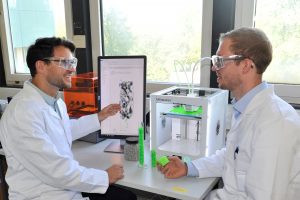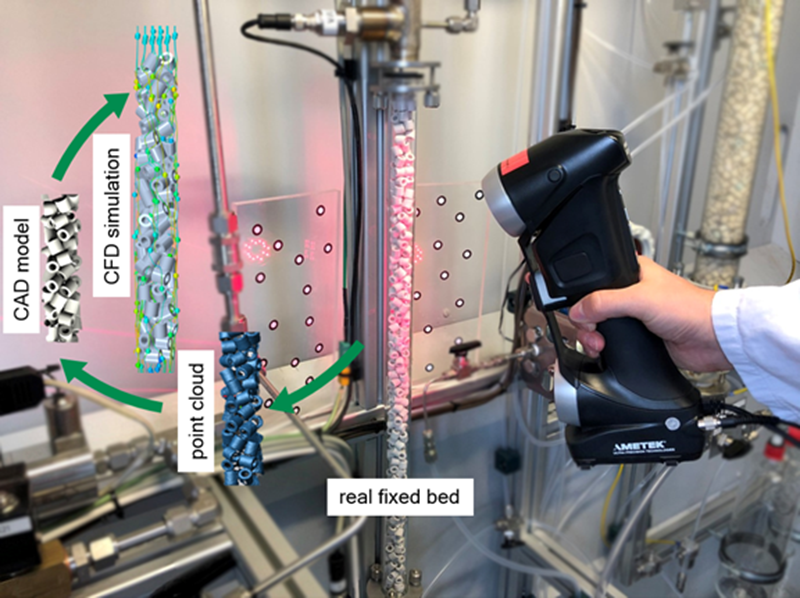June 26, 2024
Mixing 3D Scanning With Chemical Engineering To Set New Quality Standards in the Industry See the articleCreation of fixed beds with Creaform’s 3D scanner for CAD comparisons and the improvement of analysis and simulation methods
The Fixed Bed Reactor (FBR) is the most frequently used type of reactor in the chemical and process industry (CPI). FBRs are mostly filled with ceramic filling material, often referred to as pellets, which serve a central function as fixed bed catalysts. An ideal pellet features a large specific surface and creates a small loss of pressure in the bed. In addition, the pellet shape significantly influences the radial heat transport and the locally occurring velocities. Consequently, there are variety of FBR pellet shapes, such as spheres, cylinders, hollow cylinders with webs, etc.
The relationship between design and FBR performance is highly complex and requires a large development expense. In particular, catalyst development in different pellet forms is associated with high costs and time requirements for their production and investigation in complex experiments. Since the demands on catalyst pellets are likely to increase in the future, for example due to the dynamic operation of FBRs, there is a lot of interest in significantly reducing the development time. The most detailed FBR models geometrically map each pellet in the reactor. The flow in the interstitial spaces, energy and mass transport in the gas phase, in the solid pellets, and surface or gas phase reactions are resolved throughout the reactor using the finite volume method. These Computational Fluid Dynamic (CFD) simulations provide insights into FBRs that are experimentally only possible with great effort.
3D digitalization, CAD comparisons and simulations
The Institute for Chemical and Electrochemical Process Engineering (ICVT) of the Technical University of Clausthal was founded in 1991 and belongs to the Faculty of Mathematics/Computer Science and Mechanical Engineering. Among other things, it is involved in the Research Center for Energy Storage Technologies (EST) at the Technical University of Clausthal, where it works on various projects.
As part of the project described above, the ICVT carries out exploratory work in which CFD simulations and additive manufacturing (3D printing) work hand in hand to intensify and ultimately accelerate the development of FBR pellet shapes. This research works to combine particle-resolved CFD simulations, 3D-printed plastic pellets, and subsequent experiments in rapid prototyping. With the help of optical 3D digitalization, the synthetically produced fixed beds can also be compared with physically produced and 3D digitized fixed beds. In addition to the improvement of simulation methods for the production of synthetic fixed beds, the radial porosity can also be determined.
For this project, the Institute used a Creaform HandySCAN 3D Scanner, which can be used in the laboratory or directly on the machine. For a detailed analysis of small fixed beds (inner diameter: 1 in; pellet dimensions: 6 x 6 x 6 mm) the HandySCAN BLACK scanner model was used. This offers various advantages over other 3D digitizing methods such as computed tomography (CT) or magnetic resonance tomography (MRT):
- Mobile 3D data collection in the laboratory
- Volumetric accuracy of 0.020 mm + 0.040 mm/m
- High level of detail and resolution
Conclusion
With the help of 3D digitization, the Institute for Chemical and Electrochemical Process Engineering (ICVT) at the Technical University of Clausthal can compare real bed structures with synthetically generated fixed beds and thus improve simulation methods. Furthermore, 3D digitization using mobile optical measuring methods such as the HandySCAN 3D can provide a fast and cost-effective alternative to computed tomography (CT) or magnetic resonance imaging (MRI) for the digitization of fixed beds.
| About the Institute for Chemical and Electrochemical Process Engineering at the Technical University of Clausthal
The Institute for Chemical and Electrochemical Process Engineering (ICVT) at the Technical University of Clausthal was founded in 1991 by Prof. Ulrich Hoffmann as the “Institute for Chemical Process Engineering” and worked in various fields of reaction engineering until 2004. This included, for example, reactive distillation and the development of ultrasonic reactors, reaction mills and direct methanol fuel cells. After the appointment of Prof. Thomas Turek, the successful work of the ICVT was continued together with Prof. Ulrich Kunz. From 2002, the institute was home to the junior professorship for “Chemical Apparatus,” which was represented by Prof. Urs Peuker, who has been head of the Institute for Mechanical Process Engineering and Mineral Processing Technology at the TU Bergakademie Freiberg since 2008. Since the beginning of 2014, the institute has been strengthened by the newly established junior professorship “Apparatuses of Micro Process Engineering,” to which Prof. Robert Güttel was appointed. Prof. Güttel moved to the University of Ulm in April 2015 and today heads the Institute for Chemical Engineering there. In November 2014, the name of the institute was changed to “Institute of Chemical and Electrochemical Process Engineering” to reflect the expansion of the research areas. Since March 2017, Gregor Wehinger has been strengthening the institute as assistant professor for “Dynamics of Chemical Processes”. The ICVT belongs to the Faculty of Mathematics/Computer Science and Mechanical Engineering and is also involved in the Research Center for Energy Storage Technologies (EST) at the Technical University of Clausthal. |










